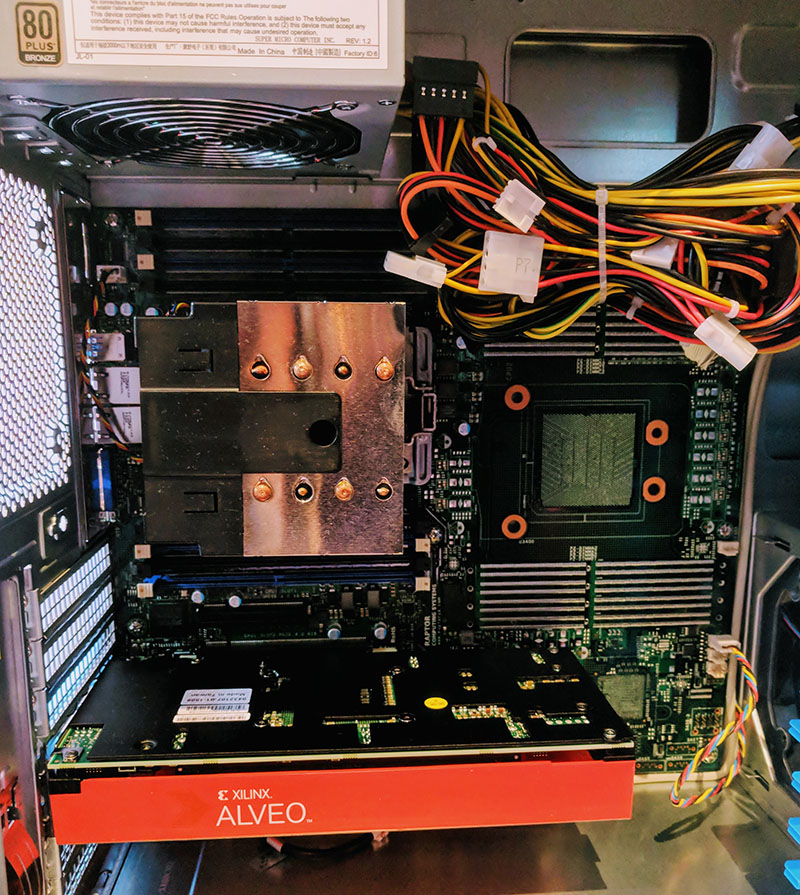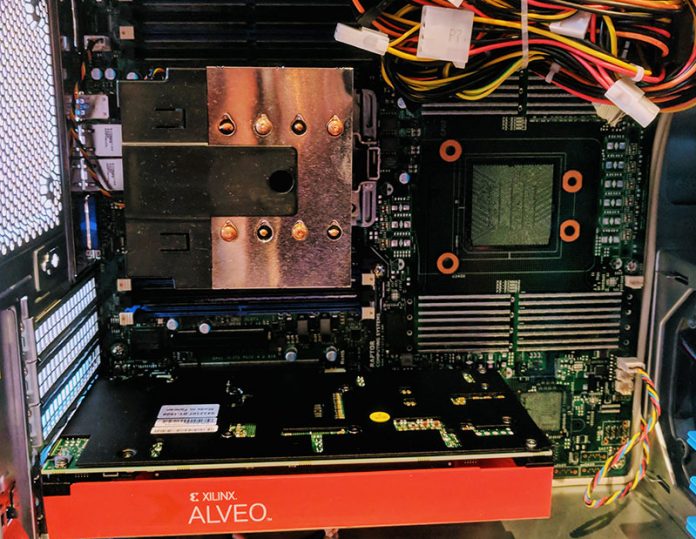At Xilinx Developer Forum 2018 there was a room dedicated to Xilinx Alveo. Patrick, our Editor-in-Chief, was at the show and wanted to cover a few of the systems he saw in the demo showcase. He wrote a piece about the Hardware Behind the AMD EPYC and Xilinx Alveo BOXX. I am helping him out and showing off the Raptor Computing Systems Talos II Lite system featured at XDF 2018. For those who do not know, Raptor Systems is the company bringing OpenPOWER systems to the development community. They have their own motherboard design and use the lower-end POWER9 scale-out CPUs to deliver systems to customers.
Raptor Computing Systems Talos II Lite POWER9 with Xilinx Alveo
Here is the tower case internals from XDF 2018. Patrick said that the tower did not have great lighting when I asked for a better photo, this is what I received. The system looks like a Talos II Lite Base Chassis (TL1BC1) from the company which comes with the heatsink, chasiss, power supply, and other bits to make the system work.

The Raptor Computing Systems Talos II Lite is a lower-cost motherboard that lacks a large number of components found on the standard Talos II motherboard.
Raptor Computing Systems Talos II Lite Specifications
Here are the key specs from Raptor Computing Systems:
- 1 POWER9-compatible CPU socket
- EATX form factor
- 8 DDR4 ECC RAM slots
- Individual 128GB DDR4 DIMM support
- Supports up to 1TB total main system memory
- 1 PCIe 4.0 x16 slot
- 1 PCIe 4.0 x8 slot
- 2 Broadcom Gigabit Ethernet ports
- 1 Microsemi SAS 3.0 controller (optional, upcharge on selection)
- 4 USB 3.0 ports
- 2 external
- 2 on internal header
- 1 USB 2.0 port
- 1 external RS-232 port
- 1 internal RS-232 port header
- 1 ASpeed BMC with OpenBMC
- 1 VGA video port
(Source: Raptor Computing Systems)
With only two PCIe 4.0 slots and only one socket present, the company dramatically reduces pricing from $2499 on the Talos II to $1099 on the Talos II Lite. We still think this is a more exciting platform than the upcoming Blackbird since it is able to take full speed 8 core and up CPUs. [Edit: the company came back on our earlier piece and said the Blackbird will support full speed 8 core CPUs]
The Xilinx Alveo is currently a PCIe 3.0 x16 card, but we hope that the next generation Xilinx Alveo with an unannounced by likely Xilinx Versal AI Core ACAP for AI Inferencing will utilize PCIe Gen4.
Final Words
For those that want to test exotic architectures, using a relatively inexpensive POWER9 platform is certainly one way to go. On the other hand, a Xilinx Alveo U250 actively cooled card is $12,995 so perhaps those who want to build a similar system will simply choose to get a full Talos II motherboard. It is still great to see these solutions being shown at trade shows.





BTW, Blackbird is also able to use full-speed 8 core CPU. This bit was already corrected by Raptor. Anyway, if Lite is better than Blackbird depends heavily on Blackbird price. If it’s high and if man doesn’t mind bigger case, then Lite is way to go especially due to much more flexible RAM configuration.
The real question that begs answering here, is whether Xilinx tools, drivers etc support the POWER platform.